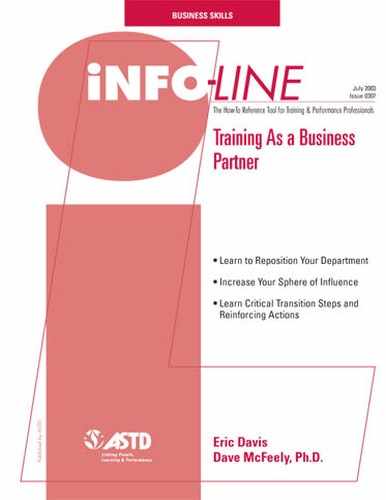Below are suggestions for the layout and content for writing an annual report.
□ Table of Contents
□ Executive Summary
This is your three-minute elevator pitch. It should contain the information most relevant to your executive team; ROI, cost savings, and strategic initiatives affected are all good examples.
The goal is to have your executives want to read the rest of the report after reading the summary.
□ Customer Base
What groups did you provide work for? Be sure to list not only classroom interventions, but also any internal consulting, meeting facilitation, or analysis work.
The goal is to show how broad your impact is on the organization.
□ Classroom Utilization
Break this down by classroom. Be sure to count not only the number of days used for training, but also any time you have an event. For example, include meetings, videoor teleconferences, and so on.
The goal is to show that you are using what you have. This is the first step for justifying additional resources.
□ Website and Learning Management System (LMS)
Report on number of participants registered, hits by month, and trends in usage.
The goal is to show this as a tool that you use. Both an LMS and a Website require funding. Showing that these tools are used throughout the organization will aid you in justifying their continued or expanded cost.
□ Instructor Utilization
The goal is to show utilization of people. Include days in the classroom (note 120 days/year is an average benchmark for preventing burnout), days of instructional design, days of class prep, and days of meeting facilitation or internal consulting.
□ Training Metrics
Level 1: Reaction sheets. It is helpful to break the questions into sub-categories if you don't already do this. For example, include instructor, materials, test or simulations, environment, and so on. Make sure you have a goal and indicate by what percentage you exceeded it or came up short.
Level 2: Test averages, performance checklists, and pre- and post-test knowledge gain are good methods for showing the increase in knowledge. Be sure to indicate any standard. For example, the score for passing might be 85 percent minimum.
Level 3: Look where you can have an impact: Reduced cycle time, reduced scrap, reduced error rate, increased customer satisfaction, and quality assurance scores are all good places to start. Ask yourself, “How will this intervention affect the employee in their position?”
Level 4: Try looking at ROI from the departmental level instead of the individual course level. Ask yourself, “What is the cost to the organization if the training department is not in place?” In terms of cost savings vs. cost avoidance, take the course that was developed internally and compare that to the cost of bringing in a consultant. In terms of revenue, if you were able to provide services for external recipients, that revenue can be used to offset your budget impact. If training is included in a sale, determine what the perceived value is and include that as an offset to your budget.
□ Financial Summary
This is generally a table showing the various components of your cost savings, revenue, and cost avoidance measures. This is where the bottom line ROI figure will reside.
The goal is to summarize all of your financial information onto one page.
□ Last Year's Milestones
Major accomplishments, goals completed, and major changes should all be included.
□ Next Year's Goals
These goals should all tie into strategic goals.
The goal of this section is to demonstrate to the executives how you will help their strategic vision come about.
□ This is not a time to be stingy.
□ Use color throughout the document.
□ Coil bind the report.
□ Use a clear cover and a vinyl back.
□ Use heavy paper. You don't want the pages to be translucent.
□ Pull quotes:
Take the most provocative numbers and add them as a pull quote to the bottom of each page. For example, cite ROI, number of students trained, knowledge gain, and so on. Another good source of pull quotes can come from your reaction surveys. Think of it as a product testimonial.
□ Use white space and graphs:
Leave plenty of white space in your document. Use charts and graphs to quickly visualize data. Be sure to add the underlying data.
□ Analyze your findings:
At the bottom of each page of data, leave enough room for a short paragraph of analysis. This is where you want to emphasize particular numbers or trends.
